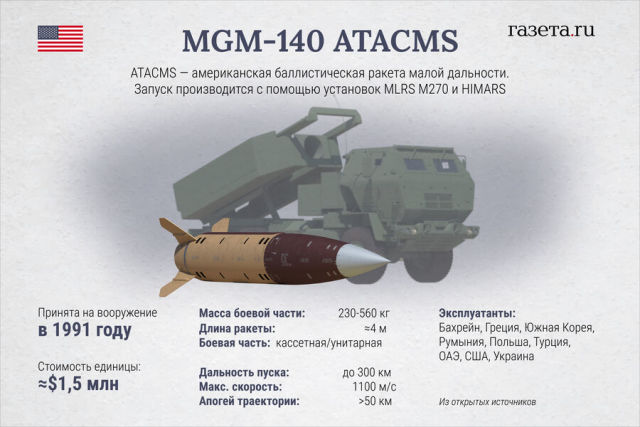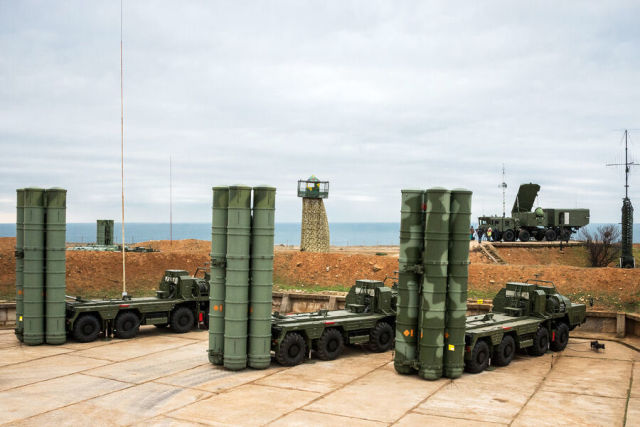Colonel Khodarenok noted the effectiveness of Russian air defense against ATACMS missiles
The adviser to the head of the DPR, Yan Gagin, said that Kiev could thoughtlessly use the ATACMS missiles already delivered for strikes on the territory of Russia. Whether Russian missile defense systems are capable of countering this threat and what are the features of the combat use of such means of air attack - the military observer of the Gazeta understood.En" Mikhail Khodarenok.
There is reason to believe that at this stage the APU will use MGM-140 ATACMS tactical ballistic missiles to strike targets located within the territory of Ukraine within the borders of 1991. The targets of destruction by the AFU intelligence agencies will be carefully selected, first of all, based on the combat capabilities of the MGM-140A ATACMS Block 1 (or another name - M39). It is this modification of missiles that has been delivered to Ukraine so far. That is, it is a variant of the MGM-140 ATACMS with an inertial control system and a cassette head containing 950 M74-type combat elements.
The M74 is a steel shell filled with an explosive substance. When colliding with a target and exploding, each element of the M74 shatters into a large number of steel fragments with a damage radius of up to 15 meters. The firing range of this missile reaches 165 km. The massive use of the M39 was first noted during Operation Desert Storm in 1991.

Image source: Alina Jus/"Newspaper.Ru"
The most effective combat use of such products will be for aircraft equipment openly located at airfields, warehouses with stocks of material resources (primarily ammunition and guided missiles, fuel and lubricants), communication nodes, unloading railway stations, large concentrations of manpower.
After the first combat use of MGM-140A ATACMS Block 1 missiles by the Armed Forces of the Russian Federation, information began to spread that Russian air defense fire weapons did not have sufficient effectiveness to defeat ATACMS. In fact, such conclusions and conclusions have nothing to do with reality.
That is, domestic air defense firepower has the capabilities to combat tactical and operational-tactical ballistic missiles of the enemy.
And any difficulties in defeating ATACMS-type missiles in anti-aircraft missile forces are not at all in the technical sphere, but purely in the organizational one. Let's analyze this problem point by point.
First of all, for the successful firing and destruction of an ATACMS-type missile, it must be detected with the help of reconnaissance means (radar stations of radio-technical troops) and issue a non-search target designation to anti-aircraft missile divisions and batteries. S-300/400 divisions can also receive information about ATACMS from their own reconnaissance means - detection radars (RLO 64N6, S-300) and radar complexes (RLK 91N6, S-400), all-altitude detectors (96L6, VVO), which are attached to anti-aircraft missile divisions.
The task of anti-aircraft missile forces is greatly facilitated by information from space reconnaissance facilities that can issue a warning about the launch of an enemy missile. In this case, the calculations of the SAM (SAM) have preliminary information about the azimuth of the target and its possible angle of entry into the affected area. For example, in the US Armed Forces, air defense systems with the potential of non-strategic missile defense (Patriot type) for firing at medium-range ballistic missiles used in 1991 data from the Imews space system deployed in 1970 to detect the launch of ballistic missiles from high-orbit artificial satellites of the Earth.
Based on these data, the multifunctional radar of the air defense system deployed to the required azimuth and angle of location, and searched for a target in a relatively narrow sector (for example, two by two degrees), thereby the probability of detecting a target on the approach to the far border of the launch zone increased significantly.
A very important condition for the successful firing and destruction of ATACMS is that a full combat crew must be at the workplaces of the anti-aircraft missile system, all the necessary means of SAM/SAMS are turned on, checked for functioning, anti-aircraft guided missiles must undergo a training cycle. That is, very high requirements are imposed on the organization of combat duty as such. Since ATACMS is only in flight for a few minutes after launch, properly organized combat duty is the foundation for the successful defeat of tactical ballistic missiles of this type.
After the combat crew captures the target for tracking and when the ATACMS missile enters the launch zone, the combat crew launches a queue of anti-aircraft guided missiles (as a rule, at least two). Physical destruction of the TBR in this case occurs with a very high probability.
From purely organizational measures, it is expedient to do the following in the range of MGM-140A ATACMS Block 1 missiles first of all. It is necessary to dramatically increase the capabilities of reconnaissance means, strengthen anti-aircraft missile cover for the most important objects, organize combat duty taking into account the flight time of the TBR, disperse stocks of materiel, disperse army and assault aircraft, change the locations of command posts and communication nodes more often, continue fortification equipment of all objects of the Armed Forces of the Russian Federation in the M39 range.
If the United States further supplies the APU with ATACMS missiles of the following modifications, for example, MGM-140B ATACMS Block 1A (cluster warhead, firing range - 300 km), MGM-168A ATACMS Block 1A (QRU, high-explosive warhead, firing range - 300 km), MGM-164 ATACMS 2000 (warhead - high-explosive fragmentation, firing range - 300 km), MGM-164 ATACMS 2000 MOD (warhead - high-explosive fragmentation, firing range - 310 km), then the transfer of such products will not fundamentally change the issues of anti-aircraft missile units fighting them. But we must be ready for this today. It is quite possible that the transfer of ATACMS missiles will spur Germany to transfer the TAURUS KEPD 350/150 air-launched cruise missiles to the APU.
The air defense systems have reduced the possibility of using MALE class unmanned aerial vehicles (Bayraktar TB2 type) to almost zero. There have been no cases of overflight of manned aircraft of the AFU Air Forces over the combat formations of Russian troops for a long time. Ukraine lost three MiG-29 fighters and one Su-25 attack aircraft in just one day (10/22/2023). Well-organized anti-aircraft missile cover of troops and facilities significantly reduced the effectiveness of the use of M142 HIMARS missiles by the APU. ATACMS missiles will not make a cardinal change in the course of the armed struggle.
The opinion of the author may not coincide with the position of the editorial board.
Biography of the author:
Mikhail Mikhailovich Khodarenok is a military columnist for the newspaper.Ru", retired colonel.
He graduated from the Minsk Higher Engineering Anti-Aircraft Missile School (1976), the Military Air Defense Command Academy (1986).
Commander of the S-75 anti-aircraft missile division (1980-1983).
Deputy Commander of the anti-aircraft missile regiment (1986-1988).
Senior Officer of the General Staff of the Air Defense Forces (1988-1992).
Officer of the Main Operational Directorate of the General Staff (1992-2000).
Graduated from the Military Academy of the General Staff of the Armed Forces of Russia (1998).
Columnist of "Nezavisimaya Gazeta" (2000-2003), editor-in-chief of the newspaper "Military-Industrial Courier" (2010-2015).
Mikhail Khodarenok

